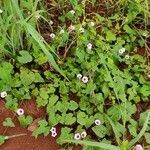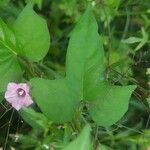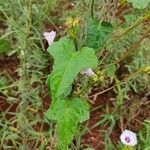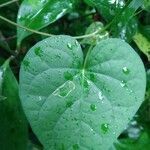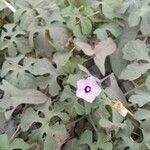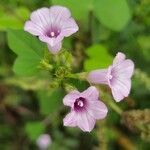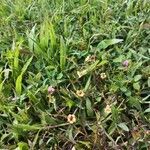Herb with twining or sometimes prostrate stems, 1-3 m long, glabrous or sparsely hairy, mainly at the nodes. Leaves broadly ovate to orbicular in outline, rarely narrower, 2½-8 by 2-7 cm, entire, coarsely dentate to more or less deeply 3-lobed, base cordate, basal lobes rounded or angular to lobed, upper and lower surface glabrous or sparsely pilose; petiole slender, 3—10(-18) cm, glabrous, or sometimes minutely tuberculate. Inflorescences axillary; peduncle shorter to longer than the petiole, 1—10(-12) cm, slightly thicker than this, glabrous, angular, minutely verrucose towards the apex, 1-flowered or cymosely few-to several-flowered; branches of the cyme very short, flowers aggregate. Pedicels more or less angular, minutely verrucose, glabrous, 2½-8 mm. Bracts minute, lanceolate-oblong. Sepals slightly unequal, 7-8(-10) mm long, the outer ones a little shorter, oblong to narrowly elliptic-oblong, obtuse or acutish, mucronulate, glabrous or sparsely hairy on the back, the margins always distinctly fimbriate; inner sepals somewhat broader, elliptic-oblong, acute, mucronulate, glabrous or sparsely hairy. Corolla funnel-shaped, ca 18-20 mm long, glabrous, pink or pale red-purple, sometimes with a darker centre, the limb with short obtuse, mucronulate lobes. Stamens included, filaments hairy at the base. Ovary hairy. Capsule subglobu-lar, 5-6 mm high, apiculate by the base of the style, bristly hairy, 2-celled, 4-valved. Seeds 4 or less, 3½ mm long, glabrous.
More
Herbs annual. Stems twining or prostrate, glabrous or nodes sparsely pubescent. Petiole 2.5-6 cm, glabrous, sometimes tuberculate; leaf blade broadly ovate to circular in outline, 2.5-7 X 2-6 cm, glabrous or sparsely pilose, base cordate, margin entire or coarsely dentate to deeply 3-lobed. Inflorescences dense umbellate cymes, 1-to several flowered; peduncle 2.5-5.5 cm, glabrous, angular, verruculose distally; bracts lanceolate-oblong, minute. Pedicel 5-7 mm, ± angular, glabrous, verruculose. Sepals slightly unequal, 5-8 mm, glabrous or sparsely pilose abaxially, margin fimbriate, apex obtuse or acute, mucronulate; outer 2 oblong, slightly shorter; inner 3 elliptic-oblong. Corolla pink or pale purple, funnelform, 1.5-2 cm, glabrous; limb obtusely 5-lobed. Stamens included. Pistil included; ovary pubescent. Stigma 2-lobed. Capsule ± globular, 5-6 mm, bristly pubescent, apiculate, 2-loculed, 4-valved. Seeds dark brown, ca. 3.5 mm, glabrous. 2n = 30.
A creeping and twining herb. It has milky sap. The leaves can be entire or have 3 lobes. The leaf stalks are long. The flowers occur in small clusters in the axils of leaves. The flower is funnel shaped and pink or purple. The fruit is a capsule which opens by 4 valves. There are 4 seeds inside. The seed are 3.5 cm across. They have a smooth dull surface. They are mottled black.
Flowers white, mauve, pink or pale red-purple 3/4-1 in. long.
Sepals long-ciliate; density of indumentum very variable
A glabrous twiner and trailer with rather angular stems
Grasslands, thickets, hedges, waste places, waysides, fields, also in savannah-forests and occasionally on sandy sea-shores, from sea-level to 750 m. Flowers closing before noon.
More
Grassland, thickets, hedges, waste places, savannah forests, along roadsides, and occasionally on sandy beaches, at elevations from sea-level to 750 metres.
A tropical plant. It grows naturally along roadsides and hedges.
